Unit 6 Nature in words_高二英语外研版(2019)选择性必修第三册教材习题精讲课件(共33张,内嵌音频)
文档属性
| 名称 | Unit 6 Nature in words_高二英语外研版(2019)选择性必修第三册教材习题精讲课件(共33张,内嵌音频) |  | |
| 格式 | pptx | ||
| 文件大小 | 8.9MB | ||
| 资源类型 | 教案 | ||
| 版本资源 | 外研版(2019) | ||
| 科目 | 英语 | ||
| 更新时间 | 2025-04-02 21:54:03 | ||
图片预览


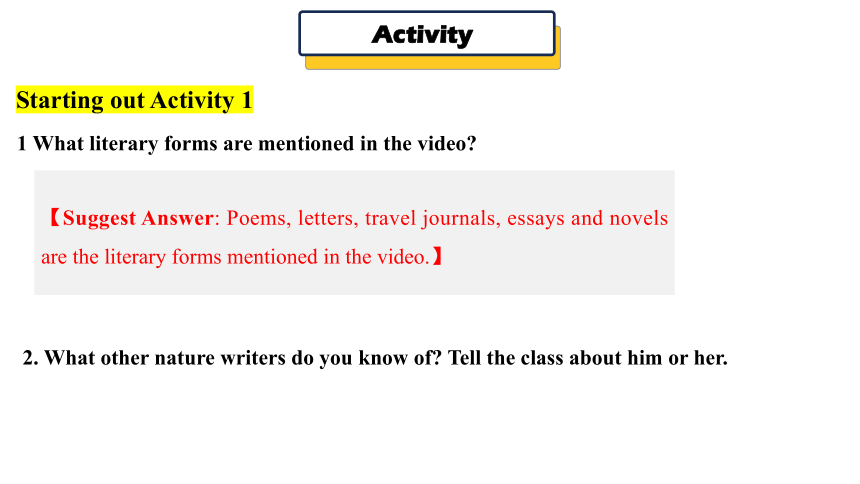
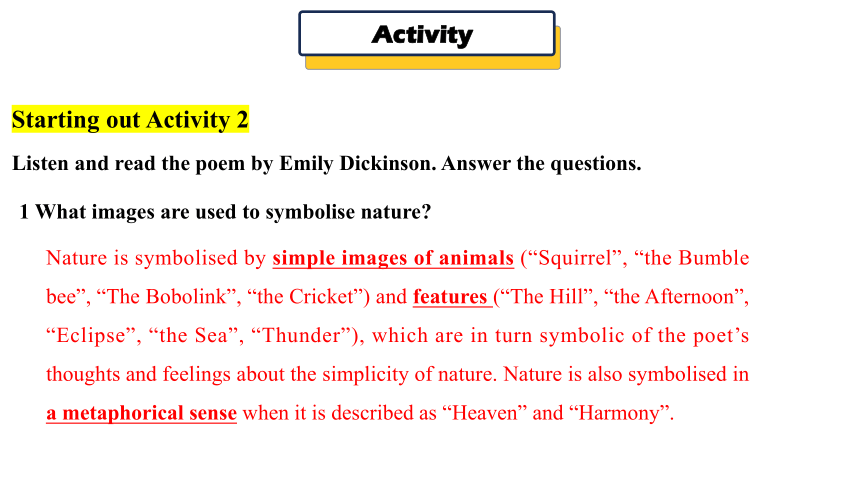
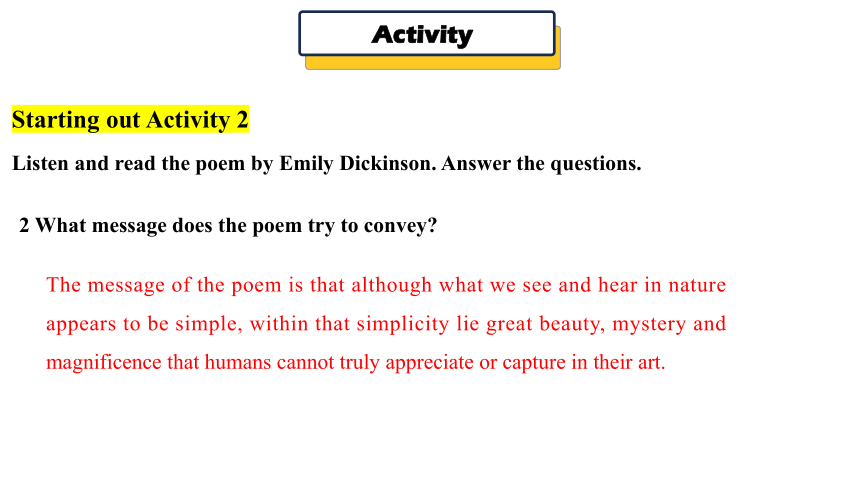
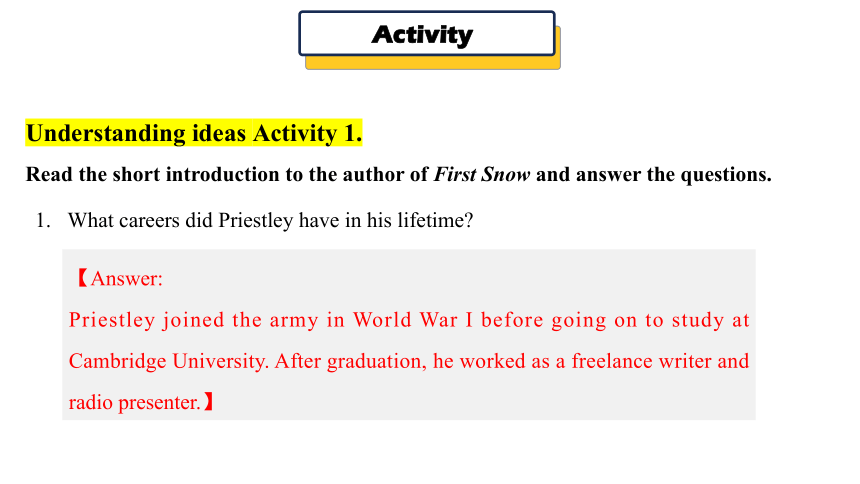
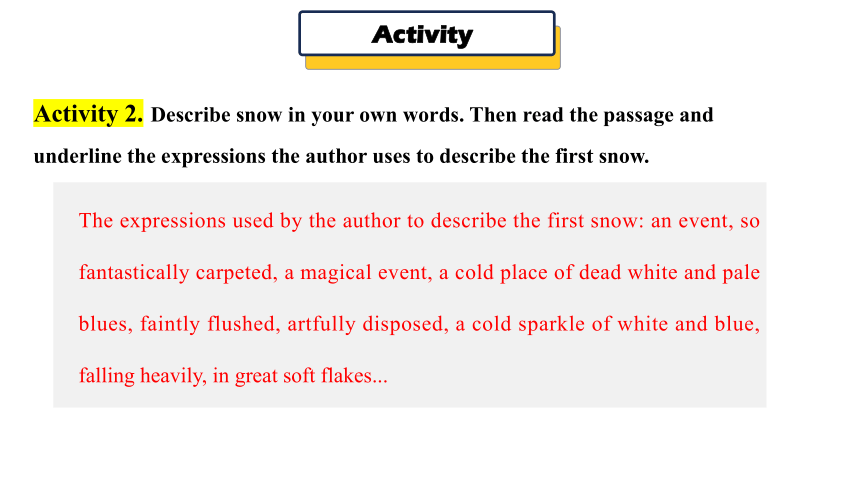
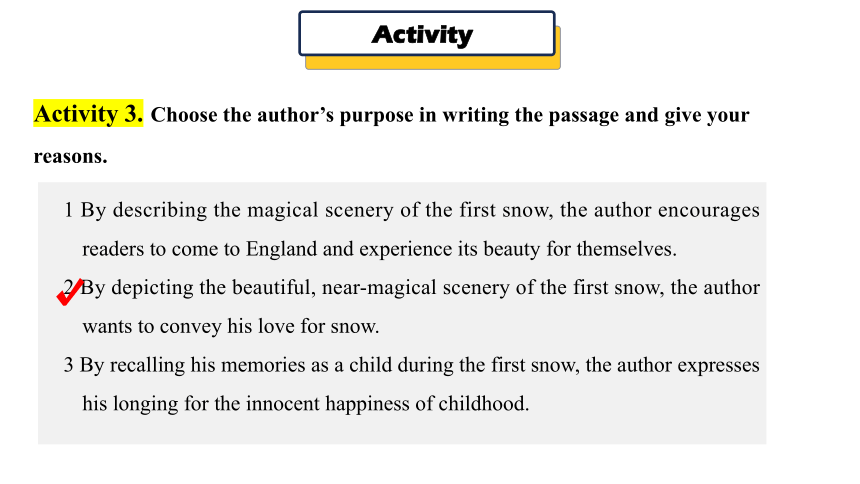

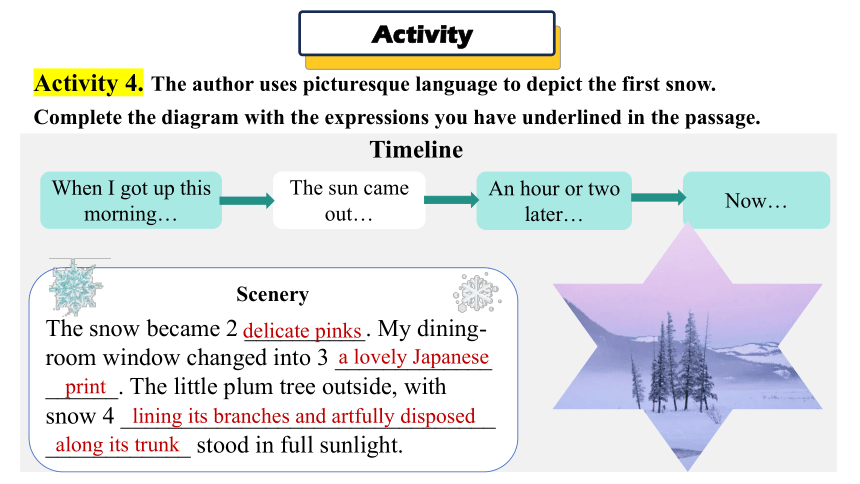

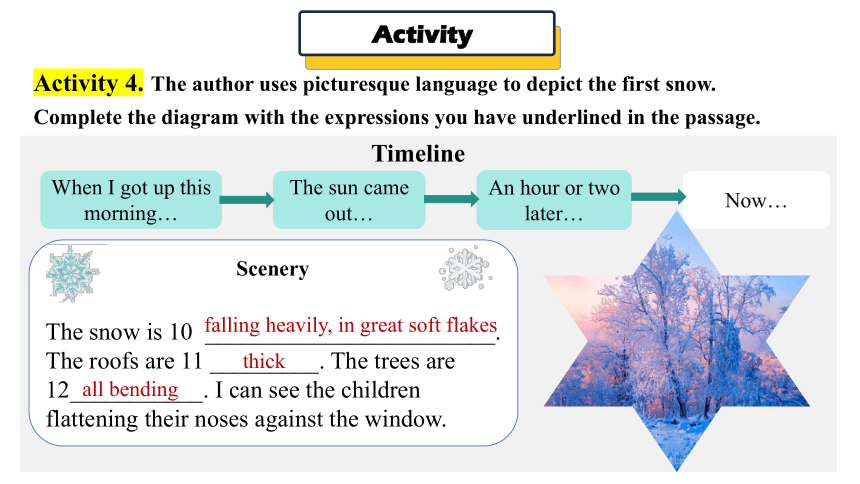
文档简介
(共33张PPT)
教材习题
Unit 6
Nature in words
01
Understanding ideas
Starting out Activity 1
Activity
1 What literary forms are mentioned in the video
【Suggest Answer: Poems, letters, travel journals, essays and novels are the literary forms mentioned in the video.】
2. What other nature writers do you know of Tell the class about him or her.
Activity
Starting out Activity 2
Listen and read the poem by Emily Dickinson. Answer the questions.
1 What images are used to symbolise nature
Nature is symbolised by simple images of animals (“Squirrel”, “the Bumble bee”, “The Bobolink”, “the Cricket”) and features (“The Hill”, “the Afternoon”, “Eclipse”, “the Sea”, “Thunder”), which are in turn symbolic of the poet’s thoughts and feelings about the simplicity of nature. Nature is also symbolised in a metaphorical sense when it is described as “Heaven” and “Harmony”.
Activity
Starting out Activity 2
Listen and read the poem by Emily Dickinson. Answer the questions.
2 What message does the poem try to convey
The message of the poem is that although what we see and hear in nature appears to be simple, within that simplicity lie great beauty, mystery and magnificence that humans cannot truly appreciate or capture in their art.
Understanding ideas Activity 1.
Read the short introduction to the author of First Snow and answer the questions.
Activity
【Answer:
Priestley joined the army in World War I before going on to study at Cambridge University. After graduation, he worked as a freelance writer and radio presenter.】
What careers did Priestley have in his lifetime
Activity 2. Describe snow in your own words. Then read the passage and underline the expressions the author uses to describe the first snow.
Activity
The expressions used by the author to describe the first snow: an event, so fantastically carpeted, a magical event, a cold place of dead white and pale blues, faintly flushed, artfully disposed, a cold sparkle of white and blue, falling heavily, in great soft flakes...
Activity 3. Choose the author’s purpose in writing the passage and give your reasons.
Activity
1 By describing the magical scenery of the first snow, the author encourages readers to come to England and experience its beauty for themselves.
2 By depicting the beautiful, near-magical scenery of the first snow, the author wants to convey his love for snow.
3 By recalling his memories as a child during the first snow, the author expresses his longing for the innocent happiness of childhood.
√
Activity 4. The author uses picturesque language to depict the first snow.
Complete the diagram with the expressions you have underlined in the passage.
Activity
Timeline
When I got up this morning…
The sun came out…
An hour or two later…
Now…
The world became a 1 ___________________
____________. The light coming through the windows seemed quite strange, and it made the familiar business of splashing and shaving and brushing and dressing very strange too.
cold place of dead white
and pale blues
Scenery
Activity
Timeline
When I got up this morning…
The sun came out…
An hour or two later…
Now…
The snow became 2 __________. My dining-room window changed into 3 _____________ ______. The little plum tree outside, with snow 4 _______________________________
____________ stood in full sunlight.
lining its branches and artfully disposed
a lovely Japanese
print
along its trunk
delicate pinks
Scenery
Activity 4. The author uses picturesque language to depict the first snow.
Complete the diagram with the expressions you have underlined in the passage.
Activity
Timeline
When I got up this morning…
The sun came out…
An hour or two later…
Now…
Everything was a 5 _____________________. The ground 6 _______________, the sky was 7 _________, and all the trees 8 ___________
__________________. The entire scene looked 9 _________________.
so many black
went on and on
thick grey
cold sparkle of white and blue
and threatening shapes
like a cruel grassland
Scenery
Activity 4. The author uses picturesque language to depict the first snow.
Complete the diagram with the expressions you have underlined in the passage.
Activity
Timeline
When I got up this morning…
The sun came out…
An hour or two later…
Now…
The snow is 10 ________________________. The roofs are 11 _________. The trees are 12___________. I can see the children flattening their noses against the window.
thick
all bending
falling heavily, in great soft flakes
Scenery
Activity 4. The author uses picturesque language to depict the first snow.
Complete the diagram with the expressions you have underlined in the passage.
By referencing the characters of jane Austen, who is known for her witty, perceptive observations of early 19th century English country life, the author is emphasising the irony and self-awareness with which he goes on to make his statement about the first snow.
1. Why does the author mention Jane Austen at the beginning of the passage
Think & share
Images used by the author to enhance the description of snow: a cold place of dead white and pale blues, flushing the snow with delicate pinks, a cold sparkle of white and blue, falling heavily, in great soft flakes...
2. What images does the author use to enhance the description of snow
02
Using language
Activity 1. Look at the sentences from the reading passage and answer the questions.
Activity
1 What is the difference between the verbs in bold in sentences (a) and (c)
“Carpeted” in sentence (a) is a past participle used as complement and “flattening” in sentence (c) is a present participle used as complement.
Activity 1. Look at the sentences from the reading passage and answer the questions.
Activity
2 In sentence (b), does “to find” indicate purpose or result
In sentence (b), “to find” indicates result.
3 In sentence (d), does “to watch” indicate purpose or result What is the function of “falling”
In sentence (d), “to watch” indicates purpose; “falling” is an attributive used to describe the snow.
Activity 2. Complete the passage with the correct form of the verbs in brackets.
Activity
The Lake Poets were a small group of poets 1 (live) in the Lake District of England in the late 18th and early 19th centuries. The Lake District, 2 (know) for its beauty, is in the north-west of England. The first of the poets 3 ____________ (come) there was Robert Southey, one of the most 4 (respect) poets of his time. He was followed by William Wordsworth, perhaps Britain’s most 5 _________ (celebrate) 19th century poet, and then Samuel Coleridge, who had written the 6 (pioneer) work Lyrical Ballads with Wordsworth. Soon, 7__________ (draw) both by its natural beauty and a desire to be near these famous poets,other poets came 8 (live) in the Lake District. All of these poets were seen as part of the Romantic Movement.
living
known
to come/coming
respected
celebrated
pioneering
drawn
to live
There is no month in the whole year in which nature wears a more beautiful appearance than in the month of August. Spring has many beauties, and May is a fresh and blooming month, but the charms of this time of year are enhanced by their contrast with the winter season. August has no such advantage. It comes when we remember nothing but clear skies, green fields, and sweet-smelling flowers – when the memory of snow, and ice, and bleak winds, has faded from our minds as completely as they have disappeared from the earth – and yet what a pleasant time it is! Orchards and fields sing with the sound of work; trees bend beneath the thick clusters of rich fruit which bow their branches to the ground; and the wheat, piled in graceful sheaves, or waving in every gentle wind that sweeps above it, tinges the landscape with a golden colour. A soft, pleasant light appears to hang over the whole earth; the influence of the season seems to extend itself even to a passing wagon, whose slow motion across the well-reaped field is seen by the eye, but makes no loud noises upon the ear.
(Adaptation from The Pickwick Papers by Charles Dickens)
Activity 5. Read the paragraph and answer the questions. Pay attention to the words in bold.
Activity
Activity 5. Read the paragraph and answer the questions. Pay attention to the words in bold.
Activity
What does this paragraph mainly describe
This paragraph mainly describes the beautiful appearance in the month of August.
What aspects does the author describe
The author describes the skies, fields, flowers, orchards, trees, wheat and the quality of the light.
Activity 6. Put the words in Activity 5 into the boxes. Find out what they are used to describe.
Activity
loud
Sound
Shape
Colour
Smell
Action
Sensation
fresh, sweet-smelling
blooming, bend, bow, piled, waving, sweep, tinges, makes
thick clusters, graceful sheaves
clear, green, rich, golden
fresh, bleak, gentle, soft, pleasant
Activity 7. Listen to the conversation and answer the questions.
Activity
1 What book was the man reading
2 Why was the man annoyed
3 What was the girl’s opinion
The man was reading a book called Landmarks.
Activity 8. Listen to the conversation again and correct the mistakes in the man’s blog.
Activity
Recently I was reading a book called Landmarks by Robert Macfarlane. What the author wrote made me feel confused. He said that many words describing nature were being added to the new version of the junior dictionary. These are words like “pasture” and “bluebell”. A “pasture” is a dense forest for cows and horses to eat. “Bluebells” are fruit shaped like bells. The reason why they are doing this is that they think these words are irrelevant to children, so instead they’ve replaced them with terms like “film”. Perhaps the dictionary does have a point, because most children don’t get out into nature that much nowadays. They spend all their time watching TV instead. But it’s a pity. In my opinion,these words form part of our literature. They add colour to our lives, and shouldn’t be lost. My granddaughter has the same opinion as me. She says we are losing old words all the time. And as times change, old words become as normal to young people as the new ones are to me.
annoyed
now missing from
field of grass
blue flowers
a different opinion from
history
blog
on computers
new words become as normal to young people as the old ones are to me
Activity 9. Complete the boxes with the expressions from the conversation.
Activity
Giving examples
... such as...
..., for instance.
Giving explanations
The main reason...
Two reasons, I think.
Consider...
03
Developing ideas
Activity 1. Look at the infographic below and answer the questions.
Activity
Facts about DDT:
DDT was first produced in 1874 and was
later used as pesticide.
It stays in the environment.
It is highly poisonous to living organisms,
including humans.
Now banned in many countries, it is still
used in some for malaria control.
Activity 1. Look at the infographic below and answer the questions.
Activity
1 How does DDT reach the human body in the food chain
2 What harm does DDT cause
When DDT is sprayed onto plants in order to kill insects, it is absorbed by plants and subsequently onsumed by animals; humans in turn eat those animals. DDT also leaks through the soil and into rivers and lakes, where it contaminates fish consumed by humans.
DDT is highly poisonous to living organism, including humans
Activity 2. Read the book review on Silent Spring, a book that led to the banning of DDT. Predict what will be mentioned in the passage.
Activity
It is a book review on Silent Spring, so the following parts may be mentioned in the passage:
1) basic information about the book, including the author, year of publication, theme and main idea;
2) the reason why this book is published;
3) features of the writing;
4) comments on this book;
5) influence of this book.
Activity 3. Organise information from the passage and complete the notes about Silent Spring.
Activity
1962
the damaging effects of human activity
more responsible, limited and carefully monitored
scientific information, examples and research
beautiful and elegant
The pesticide industry
defend her claims
The use of DDT
Presidential Medal of Freedom
environmental awareness
Think & share
1 Why was Silent Spring so successful
【Suggest Answer: Silent Spring was so successful because it alerted the general public to the dangers of DDT. It planted important new ideas in the public mind, such as that spraying chemicals to control insect populations has an impact on other wildlife, and that the chemicals got into the food chain.】
2 What is the moral lesson behind “A Fable for Tomorrow”
【Suggest Answer: The moral lesson is that financial profit should not come at the expense of the environment and the creatures living in it.】
Think & share
3 Why did some people challenge Carson’s findings
【Suggest Answer: Some people challenged Carson’s findings because they were concerned about the negative impact they would have on business in the pesticide industry.】
4 In what different ways do First Snow and Silent Spring raise people’s awareness of nature
【Suggest Answer: First Snow shows the beauty of nature—and in particular the snow—through its words and imagery, while Silent Spring describes an unnatural spring without the beauty of birdsong. They each raise people’s awareness of nature by highlighting the interplay between nature and human behavior.】
Activity 5. Read the poems and tick the correct box(es) for each question.
Activity
√
√
√
√
√
√
√
【Sample】
There once was a boy who thought,
He could eat all the sweets he had bought.
He gobbled them down,
Then started to frown,
‘Cause he’d eaten more than he ought.
Activity
THANKS
教材习题
Unit 6
Nature in words
01
Understanding ideas
Starting out Activity 1
Activity
1 What literary forms are mentioned in the video
【Suggest Answer: Poems, letters, travel journals, essays and novels are the literary forms mentioned in the video.】
2. What other nature writers do you know of Tell the class about him or her.
Activity
Starting out Activity 2
Listen and read the poem by Emily Dickinson. Answer the questions.
1 What images are used to symbolise nature
Nature is symbolised by simple images of animals (“Squirrel”, “the Bumble bee”, “The Bobolink”, “the Cricket”) and features (“The Hill”, “the Afternoon”, “Eclipse”, “the Sea”, “Thunder”), which are in turn symbolic of the poet’s thoughts and feelings about the simplicity of nature. Nature is also symbolised in a metaphorical sense when it is described as “Heaven” and “Harmony”.
Activity
Starting out Activity 2
Listen and read the poem by Emily Dickinson. Answer the questions.
2 What message does the poem try to convey
The message of the poem is that although what we see and hear in nature appears to be simple, within that simplicity lie great beauty, mystery and magnificence that humans cannot truly appreciate or capture in their art.
Understanding ideas Activity 1.
Read the short introduction to the author of First Snow and answer the questions.
Activity
【Answer:
Priestley joined the army in World War I before going on to study at Cambridge University. After graduation, he worked as a freelance writer and radio presenter.】
What careers did Priestley have in his lifetime
Activity 2. Describe snow in your own words. Then read the passage and underline the expressions the author uses to describe the first snow.
Activity
The expressions used by the author to describe the first snow: an event, so fantastically carpeted, a magical event, a cold place of dead white and pale blues, faintly flushed, artfully disposed, a cold sparkle of white and blue, falling heavily, in great soft flakes...
Activity 3. Choose the author’s purpose in writing the passage and give your reasons.
Activity
1 By describing the magical scenery of the first snow, the author encourages readers to come to England and experience its beauty for themselves.
2 By depicting the beautiful, near-magical scenery of the first snow, the author wants to convey his love for snow.
3 By recalling his memories as a child during the first snow, the author expresses his longing for the innocent happiness of childhood.
√
Activity 4. The author uses picturesque language to depict the first snow.
Complete the diagram with the expressions you have underlined in the passage.
Activity
Timeline
When I got up this morning…
The sun came out…
An hour or two later…
Now…
The world became a 1 ___________________
____________. The light coming through the windows seemed quite strange, and it made the familiar business of splashing and shaving and brushing and dressing very strange too.
cold place of dead white
and pale blues
Scenery
Activity
Timeline
When I got up this morning…
The sun came out…
An hour or two later…
Now…
The snow became 2 __________. My dining-room window changed into 3 _____________ ______. The little plum tree outside, with snow 4 _______________________________
____________ stood in full sunlight.
lining its branches and artfully disposed
a lovely Japanese
along its trunk
delicate pinks
Scenery
Activity 4. The author uses picturesque language to depict the first snow.
Complete the diagram with the expressions you have underlined in the passage.
Activity
Timeline
When I got up this morning…
The sun came out…
An hour or two later…
Now…
Everything was a 5 _____________________. The ground 6 _______________, the sky was 7 _________, and all the trees 8 ___________
__________________. The entire scene looked 9 _________________.
so many black
went on and on
thick grey
cold sparkle of white and blue
and threatening shapes
like a cruel grassland
Scenery
Activity 4. The author uses picturesque language to depict the first snow.
Complete the diagram with the expressions you have underlined in the passage.
Activity
Timeline
When I got up this morning…
The sun came out…
An hour or two later…
Now…
The snow is 10 ________________________. The roofs are 11 _________. The trees are 12___________. I can see the children flattening their noses against the window.
thick
all bending
falling heavily, in great soft flakes
Scenery
Activity 4. The author uses picturesque language to depict the first snow.
Complete the diagram with the expressions you have underlined in the passage.
By referencing the characters of jane Austen, who is known for her witty, perceptive observations of early 19th century English country life, the author is emphasising the irony and self-awareness with which he goes on to make his statement about the first snow.
1. Why does the author mention Jane Austen at the beginning of the passage
Think & share
Images used by the author to enhance the description of snow: a cold place of dead white and pale blues, flushing the snow with delicate pinks, a cold sparkle of white and blue, falling heavily, in great soft flakes...
2. What images does the author use to enhance the description of snow
02
Using language
Activity 1. Look at the sentences from the reading passage and answer the questions.
Activity
1 What is the difference between the verbs in bold in sentences (a) and (c)
“Carpeted” in sentence (a) is a past participle used as complement and “flattening” in sentence (c) is a present participle used as complement.
Activity 1. Look at the sentences from the reading passage and answer the questions.
Activity
2 In sentence (b), does “to find” indicate purpose or result
In sentence (b), “to find” indicates result.
3 In sentence (d), does “to watch” indicate purpose or result What is the function of “falling”
In sentence (d), “to watch” indicates purpose; “falling” is an attributive used to describe the snow.
Activity 2. Complete the passage with the correct form of the verbs in brackets.
Activity
The Lake Poets were a small group of poets 1 (live) in the Lake District of England in the late 18th and early 19th centuries. The Lake District, 2 (know) for its beauty, is in the north-west of England. The first of the poets 3 ____________ (come) there was Robert Southey, one of the most 4 (respect) poets of his time. He was followed by William Wordsworth, perhaps Britain’s most 5 _________ (celebrate) 19th century poet, and then Samuel Coleridge, who had written the 6 (pioneer) work Lyrical Ballads with Wordsworth. Soon, 7__________ (draw) both by its natural beauty and a desire to be near these famous poets,other poets came 8 (live) in the Lake District. All of these poets were seen as part of the Romantic Movement.
living
known
to come/coming
respected
celebrated
pioneering
drawn
to live
There is no month in the whole year in which nature wears a more beautiful appearance than in the month of August. Spring has many beauties, and May is a fresh and blooming month, but the charms of this time of year are enhanced by their contrast with the winter season. August has no such advantage. It comes when we remember nothing but clear skies, green fields, and sweet-smelling flowers – when the memory of snow, and ice, and bleak winds, has faded from our minds as completely as they have disappeared from the earth – and yet what a pleasant time it is! Orchards and fields sing with the sound of work; trees bend beneath the thick clusters of rich fruit which bow their branches to the ground; and the wheat, piled in graceful sheaves, or waving in every gentle wind that sweeps above it, tinges the landscape with a golden colour. A soft, pleasant light appears to hang over the whole earth; the influence of the season seems to extend itself even to a passing wagon, whose slow motion across the well-reaped field is seen by the eye, but makes no loud noises upon the ear.
(Adaptation from The Pickwick Papers by Charles Dickens)
Activity 5. Read the paragraph and answer the questions. Pay attention to the words in bold.
Activity
Activity 5. Read the paragraph and answer the questions. Pay attention to the words in bold.
Activity
What does this paragraph mainly describe
This paragraph mainly describes the beautiful appearance in the month of August.
What aspects does the author describe
The author describes the skies, fields, flowers, orchards, trees, wheat and the quality of the light.
Activity 6. Put the words in Activity 5 into the boxes. Find out what they are used to describe.
Activity
loud
Sound
Shape
Colour
Smell
Action
Sensation
fresh, sweet-smelling
blooming, bend, bow, piled, waving, sweep, tinges, makes
thick clusters, graceful sheaves
clear, green, rich, golden
fresh, bleak, gentle, soft, pleasant
Activity 7. Listen to the conversation and answer the questions.
Activity
1 What book was the man reading
2 Why was the man annoyed
3 What was the girl’s opinion
The man was reading a book called Landmarks.
Activity 8. Listen to the conversation again and correct the mistakes in the man’s blog.
Activity
Recently I was reading a book called Landmarks by Robert Macfarlane. What the author wrote made me feel confused. He said that many words describing nature were being added to the new version of the junior dictionary. These are words like “pasture” and “bluebell”. A “pasture” is a dense forest for cows and horses to eat. “Bluebells” are fruit shaped like bells. The reason why they are doing this is that they think these words are irrelevant to children, so instead they’ve replaced them with terms like “film”. Perhaps the dictionary does have a point, because most children don’t get out into nature that much nowadays. They spend all their time watching TV instead. But it’s a pity. In my opinion,these words form part of our literature. They add colour to our lives, and shouldn’t be lost. My granddaughter has the same opinion as me. She says we are losing old words all the time. And as times change, old words become as normal to young people as the new ones are to me.
annoyed
now missing from
field of grass
blue flowers
a different opinion from
history
blog
on computers
new words become as normal to young people as the old ones are to me
Activity 9. Complete the boxes with the expressions from the conversation.
Activity
Giving examples
... such as...
..., for instance.
Giving explanations
The main reason...
Two reasons, I think.
Consider...
03
Developing ideas
Activity 1. Look at the infographic below and answer the questions.
Activity
Facts about DDT:
DDT was first produced in 1874 and was
later used as pesticide.
It stays in the environment.
It is highly poisonous to living organisms,
including humans.
Now banned in many countries, it is still
used in some for malaria control.
Activity 1. Look at the infographic below and answer the questions.
Activity
1 How does DDT reach the human body in the food chain
2 What harm does DDT cause
When DDT is sprayed onto plants in order to kill insects, it is absorbed by plants and subsequently onsumed by animals; humans in turn eat those animals. DDT also leaks through the soil and into rivers and lakes, where it contaminates fish consumed by humans.
DDT is highly poisonous to living organism, including humans
Activity 2. Read the book review on Silent Spring, a book that led to the banning of DDT. Predict what will be mentioned in the passage.
Activity
It is a book review on Silent Spring, so the following parts may be mentioned in the passage:
1) basic information about the book, including the author, year of publication, theme and main idea;
2) the reason why this book is published;
3) features of the writing;
4) comments on this book;
5) influence of this book.
Activity 3. Organise information from the passage and complete the notes about Silent Spring.
Activity
1962
the damaging effects of human activity
more responsible, limited and carefully monitored
scientific information, examples and research
beautiful and elegant
The pesticide industry
defend her claims
The use of DDT
Presidential Medal of Freedom
environmental awareness
Think & share
1 Why was Silent Spring so successful
【Suggest Answer: Silent Spring was so successful because it alerted the general public to the dangers of DDT. It planted important new ideas in the public mind, such as that spraying chemicals to control insect populations has an impact on other wildlife, and that the chemicals got into the food chain.】
2 What is the moral lesson behind “A Fable for Tomorrow”
【Suggest Answer: The moral lesson is that financial profit should not come at the expense of the environment and the creatures living in it.】
Think & share
3 Why did some people challenge Carson’s findings
【Suggest Answer: Some people challenged Carson’s findings because they were concerned about the negative impact they would have on business in the pesticide industry.】
4 In what different ways do First Snow and Silent Spring raise people’s awareness of nature
【Suggest Answer: First Snow shows the beauty of nature—and in particular the snow—through its words and imagery, while Silent Spring describes an unnatural spring without the beauty of birdsong. They each raise people’s awareness of nature by highlighting the interplay between nature and human behavior.】
Activity 5. Read the poems and tick the correct box(es) for each question.
Activity
√
√
√
√
√
√
√
【Sample】
There once was a boy who thought,
He could eat all the sweets he had bought.
He gobbled them down,
Then started to frown,
‘Cause he’d eaten more than he ought.
Activity
THANKS
